Maritime / Mobility Install Guide - Performance (Gen 2) formerly Flat HP
Detailed guidelines for mobile Starlink Performance (Gen 2), formerly Flat High Performance, installations.
Get maritime installation services from Starlink Affiliate Installers, starting at 1450 USD. Fill out our pre-install survey and an Affiliate Installer will reach out.
Read First: Key Considerations for a Successful Install
-
Minimize Obstructions: Each Starlink should have a clear view of the sky 20° elevation above the horizon, 360° around the azimuth. You may need to raise the antennas on a pole/pedestal to get a clear view of the sky & good service. If you have obstructions > 20° elevation in any direction, the connection may be occasionally interrupted.
-
Orientation of the Mounts: The mounts are tilted 8° to facilitate water runoff. The wedge mount for the Performance (Gen 2) will tilt the dish such that the field of view is 12° at the lower side of the dish, and 28° at the upper side, and roughly 20° on the remaining two sides. If you are installing in an area with minor obstructions, it would be best to tilt the dish away from those obstructions. Ideally, the antennas should be tilted in the direction with the fewest obstructions. Be sure to use a removable thread locker on all threaded fasteners.

-
Orientation of the Dish & Power Supply Unit: Dish & PSU should be set up so that connectors are facing down or to the side. This is to avoid water collecting or sitting around the seal.
-
Cables: The maximum distance from the dish to the power supply is 25m (75'). The maximum total distance from the dish to the network equipment (passing through the power supply) is 100m (300'). The minimum bend radius of the cable is 5cm (2"). Sharp kinks in the ethernet cables can lower the throughput speed. The cables are not reversible. The connector on the end of the cable is specific to the device to which it connects.
-
Power: Starlink power supply input range 100-240V - 6.3A 50 - 60 Hz. Recommend using UPS-backed power supply to maintain internet connection through power dips and short power outages. The Starlink Power Supply supplies power to the dish and allows the data to pass through. For DC power sources, use a Pure Sine Wave inverter rated minimum 500W.
-
Network: Once the dish connects to the Starlink network, it allows the local device to request and be assigned an IP address. This IP will default to a CGNAT IP address unless the "Public IP" option is configured in the dashboard. More information on IP addresses can be found here
-
Multiple Starlinks: If installing multiple Starlinks in one location, the minimum separation distance from the mount center to mount center should be 0.9 meters. If multiple antennas are installed in close proximity, they should tilt away from each other. A third-party router can be used to connect the Starlinks together into one network and provide load balancing, traffic shaping, failover, and other advanced capabilities.
-
Support: It may take up to 20 minutes for Starlink to connect to the network. If you are having issues with setup, review the guidance in the Troubleshooting and Setup sections in Support. https://support.starlink.com/
Prepare for Install
Starlink App
Download the Starlink app first. The app will help you find an unobstructed install location, manage your account, test your connection, and browse the shop.
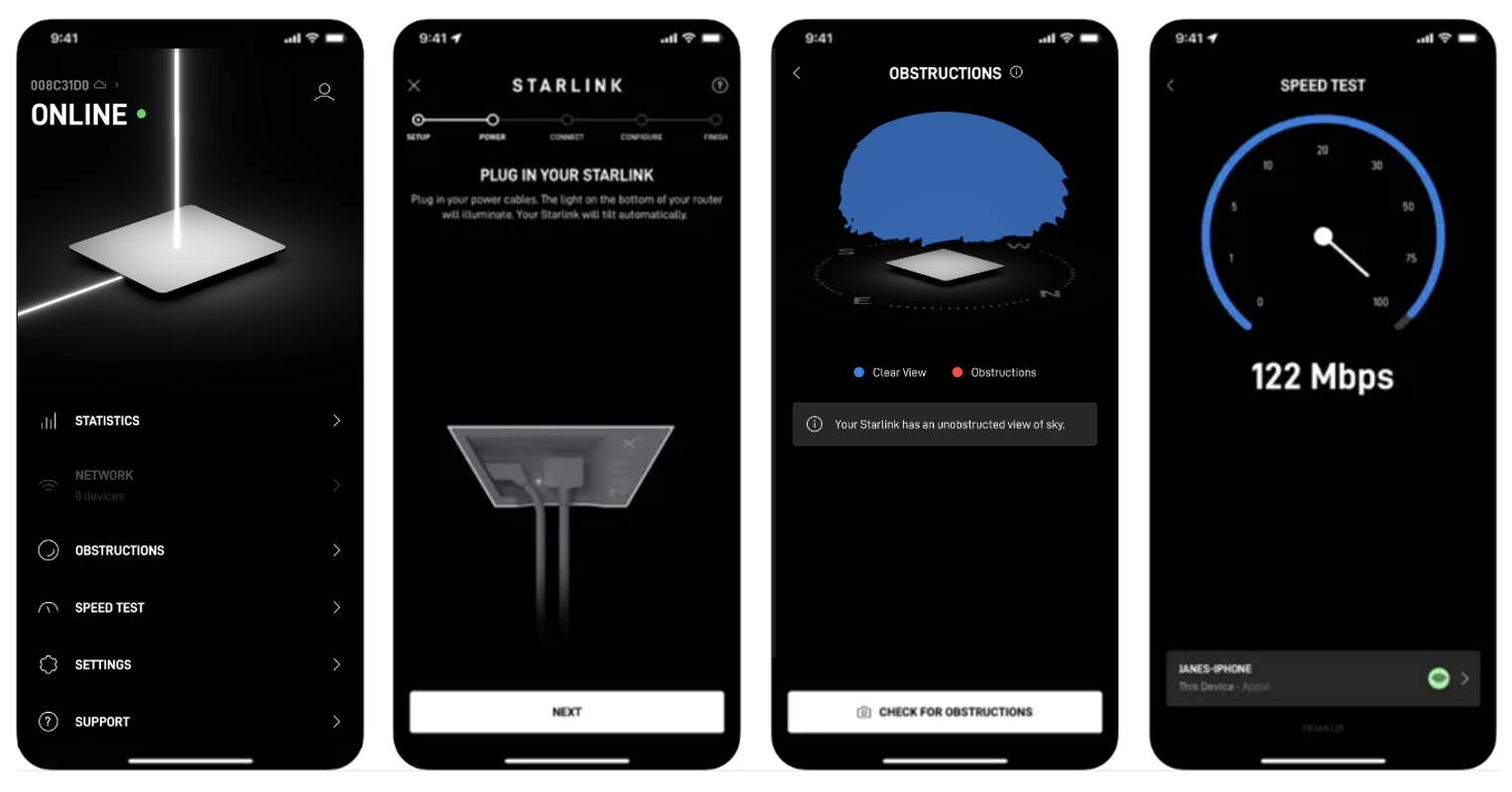
Find an Unobstructed Location

Starlink must be 100% unobstructed for best performance. Even small obstructions in the field of view will have a negative impact on the quality of the connection, including intermittent outages, dropped packets or sessions, and a reduction in overall average bandwidth capacity.
Each dish should have clear view of the sky from around 20° elevation (above the horizon), with a full 360° azimuth (rotation). If there are obstructions to the field of view, multiple dishes can be used, and load balanced with a 3rd party router. However, any dish with obstructions will result in lower than the rated performance (i.e. bandwidth throughput) from that dish. It is of utmost importance to install in a location with a clear view of the sky.
The wedge mount will tilt the dish such that the field of view is 12° at the lower side of the dish, and 28° at the upper side, and roughly 20° on the remaining two sides. If you are installing in an area with minor obstructions, it would be best to tilt the dish away from those obstructions.

Customers have been successful installing Starlink on masts, railings, elevated posts, and roofs, since the dishes are less likely to be obstructed and are better protected from salt spray.
If your Starlink will not be the tallest object in sight at the install location, be sure to use the Starlink app to ensure no obstructions such as masts, antennas, or other structures will interrupt your service.
Follow these additional guidelines for choosing your best install location:
- Do not install next to a wall or other structure
- Do not install under a covered outdoor area
- Consider an elevated install (for example, on a pedestal, post, or rooftop) as the height improves the chances of clearing nearby obstructions
Use the app to be sure you are assessing obstructions accurately: Use the Obstructions Tool in the App
Review Important Hardware Details
We have specific maritime/mobility recommendations for the Performance (Gen 2) around sealing to prevent water ingress, maximum distance for cabling, minimum bend radius, and accessories.
Ingress Protection (IP) Rating
The Starlink dish and power supply are water jet and dust resistant and has been shown to survive for long durations (>6 months) in sustained corrosive marine environments (5% NaCl which is standard per ASTM). The Starlink WiFi router is designed for indoor use and is dust and splash resistant. More details on the hardware are available here.
| Part | Code | First Digit - Solid Particles | Second Digit - Liquids |
|---|---|---|---|
| Starlink Dish | IP56 | IP5X - Dust-protected Ingress of dust is not entirely prevented, but it must not enter in sufficient quantity to interfere with the safe operation of the equipment. | IPX6 - Powerful water jets. Water projected in powerful jets against the enclosure from any direction shall have no harmful effects. |
| Starlink Power Supply | IP56 | IP5X - Dust-protected Ingress of dust is not entirely prevented, but it must not enter in sufficient quantity to interfere with the safe operation of the equipment. | IPX6 - Powerful water jets. Water projected in powerful jets against the enclosure from any direction shall have no harmful effects. |
| Starlink WiFi Router | IP54 | IP5X - Dust-protected Ingress of dust is not entirely prevented, but it must not enter in sufficient quantity to interfere with the safe operation of the equipment. | IPX4 - Splashing of water Water splashing against the enclosure from any direction shall have no harmful effect. |
To ensure maximum resistance to water ingress, please be sure the Starlink cable is fully seated before exposing the Starlink to the elements.
Sealing Cable Connections
If your cable connection is exposed to significant amounts of water, we recommend using a sealant to prevent water damage. Only non-setting sealant, like dielectric grease, should be used around the seal.
No RTV should be placed on the seal, nor on the surface that interfaces with the seal, nor on the metal part of the connector. Once the cable has been fully inserted, then Dow 737 RTV can be used on the very outside of the socket/plug interface to provide additional waterproofing.
Cable Details
The Starlink cables are not reversible. In other words, the connector on the end of the cable is specific to the device it connects to. For example, be sure to route the cable with the dish end of the cable at the location of the dish, etc.
There is a MAXIMUM distance of 25 meters from the dish to the PSU. This is due to the voltage requirements at the dish. Do not attempt to extend the cable beyond 25 meters. We do not recommend cutting and splicing this cable. The total length from the dish to the network equipment is 100 meters.
The cables are manufactured to the following standards:
Cable Standards
- GENERAL APPLICATION: INDOOR/OUTDOOR, SUNLIGHT RESISTANT
- DATA CATEGORY: 5E
- FLAME RATING: UL: CMX OUTDOOR / CMR PER NEC ARTICLE 800 UNDER UL CATEGORY DUZX
- UL FLAMMABILITY: UL 1581 VW-1, UL 1666 RISER
- CSA FLAMMABILITY: FT1
- TEMPERATURE RATING: 105°C
- OPERATION TEMPERATURE: -40°C TO 105°C
- CONSTRUCTION: 4 TWISTED PAIR
- COMPLIANCE: ROHS, REACH
Minimum bend radius for any data cable is 5cm (2"). Sharp bends or kinks in the ethernet cables can lower the throughput speed.
Accessories for each Starlink Kit can be found on the Kit-specific Specifications under “Mounts & Accessories”. We offer various alternative mounts and cable lengths you can purchase to best meet your needs. Starlink provides the following cables for purchase:
| ACCESSORY | USE CASE | DETAILS |
|---|---|---|
| Flat High Performance 8M Starlink Cable | Connection between Flat High Performance Starlink dish and Power Supply | Compatibility: Flat High Performance Starlink Kit |
| Flat High Performance 25 M Starlink Cable | Connection between Flat High Performance Starlink dish and Power Supply for longer installation distances | Compatibility: Flat High Performance Starlink Kit |
| High Performance 2 M Starlink Router Cable | Connection between the Power Supply and the Starlink Router | Compatibility: High Performance Starlink Kit, Flat High Performance Starlink Kit |
| High Performance 30 M Starlink Router Cable | Connection between the Power Supply and the Starlink Router for longer installation distances | Compatibility: High Performance Starlink Kit, Flat High Performance Starlink Kit |
| High Performance 5 M Starlink Ethernet Cable | Connection between Power Supply and the RJ45 connector (for third party routers or devices) | Compatibility: High Performance Starlink Kit, Flat High Performance Starlink Kit |
| High Performance 30 M Starlink Ethernet Cable | Connection between Power Supply and the RJ45 connector (for third party routers or devices) for longer installation distances | Compatibility: High Performance Starlink Kit, Flat High Performance Starlink Kit |
Mount the Dish
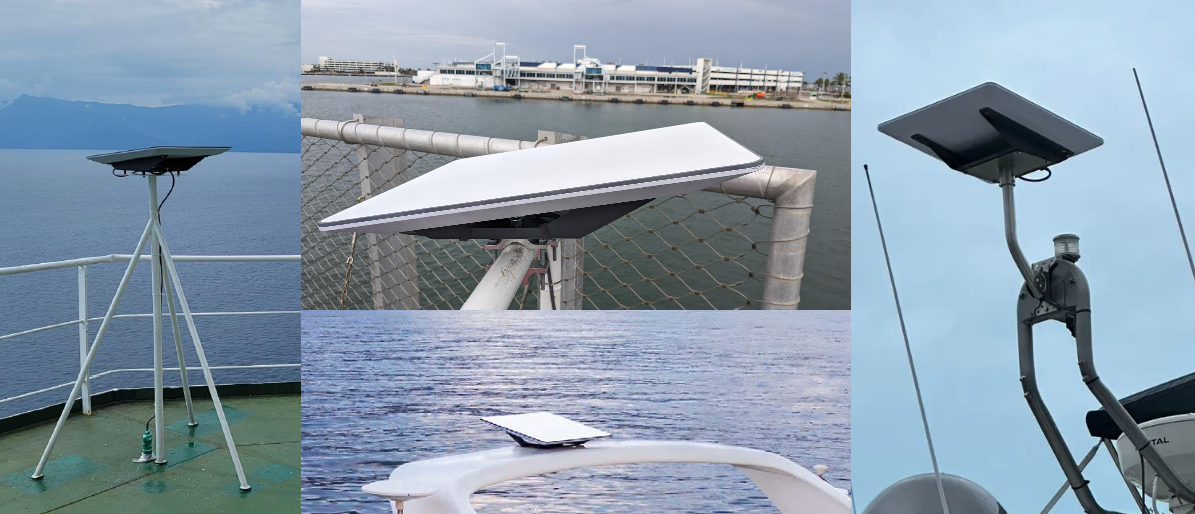
Maritime & Mobility applications are best served by the Flat High Performance Starlink (spec sheet here). For most applications, we recommend mounting using our Wedge Mount to install the dish at a slight angle. This encourages rain water to run off the dish to prevent accumulation of droplets which would impact performance by blocking the beams to/from the satellite. However, for higher-speed vehicles a flat (horizontal) installation is acceptable to minimize drag.
Be sure to use removable thread locker (for example Loctite 222) on all threaded fasteners, to prevent the faster from backing out due to vibration. Also placing silicone near the head (between head and mount, and mount and product) to seal out any water. Fastener thread is 1/4-20. Recommended torque is max 7.5 ft-lbs.
Starlink Wedge Mount Details
If you plan to use the Starlink Wedge Mount, please keep the following in mind:
- The mount should be installed on a structurally sound, horizontal surface.
- Use appropriate installation hardware for the installation surface.
- Orient the mount so the lower end of the dish has the cable connection and points forwards when in motion.
- Do not allow salt water to collect around your Starlink. Periodically check the sealant on your fasteners and rinse with fresh water.
For detailed instructions, reference the Wedge Mount Install Guide.

Other mounting solutions
Accessories for each Starlink Kit can be found on the Kit-specific Specifications under “Mounts & Accessories”. We offer various alternative mounts and cable lengths you can purchase to best meet your needs.
- Starlink Pole Mount Adapter for Flat HP: for mounting on the end of a pole or mast.
- Starlink Cruise Mount: similar to the Wedge mount but provides additional space below the Starlink to mount the power supply unit (available upon request).
- Third-party pedestal mounts (for example this product made by SeaView).
- Beam clamps or U-bolts can be used to install the wedge mount on a railing. This will require drilling into the mount.
Mount the Power Supply
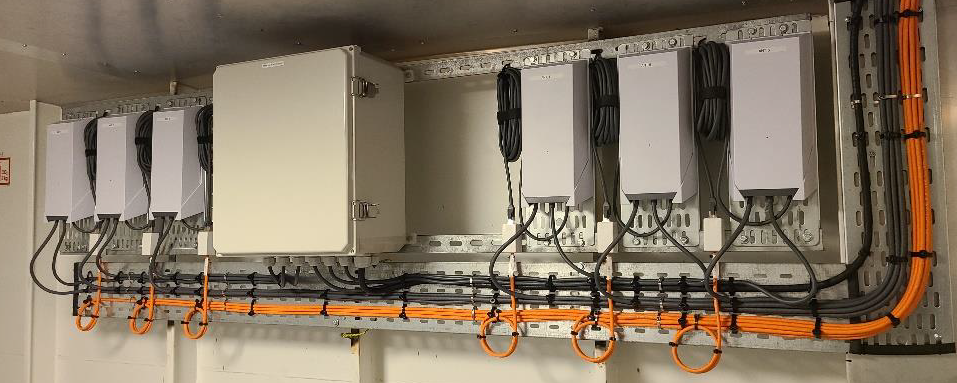
Mount the power supply using the supplied mount. The power supply is rated IP56. However, to prevent water pooling around the connectors, the power supply should be mounted with the connectors at the bottom or the side of the enclosure.
The power supply dissipates approximately 20W of heat and should be mounted in a well-ventilated environment. If it is enclosed be sure to provide a mechanism for the heat to escape. If the power supply over heats it will shut off resulting in a loss of internet connection.
Connect the Dish

Connect the Starlink dish to power supply with the provided Starlink Cable.
Once the cable is inserted into the dish, lock it into place by pushing UP on the clip until you hear a "click".
The Flat High Performance kit includes an 8 meter cable. If 8 meters is not long enough for your installation, you can purchase a 25m cable in the Starlink Shop. Due to power requirements, the cable from the power supply to the dish can not be extended beyond 25m.
Connect the Power
Use the power cable to connect the power supply and the router (if in use) to a power source supplying AC voltage.
It is recommended to power the Starlink and any downstream router from a power source protected by an Uninterruptable Power Supply (UPS) to protect the Starlink from power spikes and surges and to provide continuous power to the Starlink through minor dips (brownouts) or short power outages.
Connect the Network
OPTION 1: Use the included Starlink WiFi router.
- Use the Starlink Router cable to connect the power supply to the Starlink WiFi router.
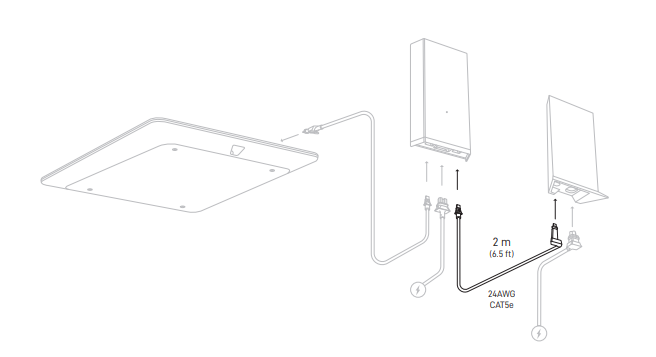
- Stand close to the router, open the Starlink app, and tap ‘Start Setup’.
- This will guide you through the setup and prompt with WiFi configuration steps like setting a Network name and password.
- No Starlink app? Find and connect to the STARLINK network in your device’s WiFi settings.
- Confirm you are connected by navigating to a website, watching a video, or running a speed test from the app while connected to Starlink. You will see an ONLINE status on the main screen of the app.
- We recommend using the Starlink router for initial setup confirmation. See the WiFi section for additional guidance
OPTION 2: Connect directly to a device or third-party router
- Use the Starlink Ethernet cable to connect the power supply directly to ethernet port of a device or to the WAN port of a third-party router.
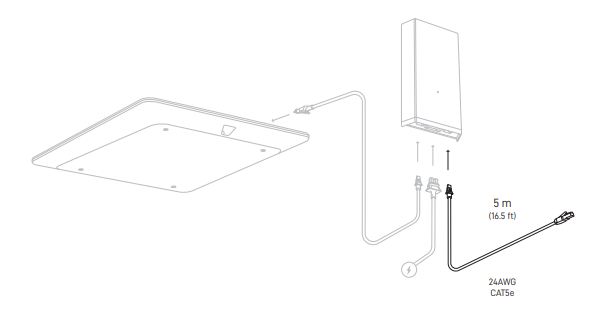
- If the ethernet connection cable is not long enough, we suggest terminating or patching the cable. If the connection is outdoors, be sure to use a weatherproof connection. This cable from the power supply to your network is standard ethernet and can be extended up to 100m.
- Connect the RJ-45 on the end of the ethernet cable to a computer or third-party router (or other network device).
- Use the computer to navigate to a website, or use the third-party router's diagnostics to confirm a connection to the internet.
- Review Using a Third Party router
- RELEVANT FAQ LINKS:
Installing Multiple Starlinks
Installing and Networking Multiple Starlinks
Connection Monitoring
Maintenance and Troubleshooting
Maintenance and Troubleshooting
Get Support
Additional Resources
- Starlink Dashboard: https://www.starlink.com/account/dashboard
- FAQ and Support: https://support.starlink.com
- Shop: https://shop.starlink.com/
- IP Addresses: https://starlink-enterprise-guide.readme.io/docs/ip-addresses
- Where in the world can I use Starlink? https://www.starlink.com/support/article/9eb841b3-2e43-a6fb-ecc7-ea58fb5600b5
Updated about 1 month ago
